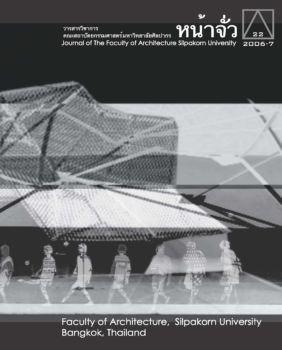เรียนรู้การถ่ายเทความร้อนจากการถ่ายภาพรังสีอินฟราเรด กรณีศึกษา: บ้านประหยัดพลังงานมหาวิทยาลัยศิลปากร
Keywords:
อุณหภูมิพื้นผิว, รังสีอินฟราเรด, บ้านประหยัดพลังงาน, surface temperature, infrared thermography, energy–efficient houseAbstract
คณะสถาปัตยกรรมศาสตร์ มหาวิทยาลัยศิลปากร ได้รับทุนสนับสนุนจากสำนักนโยบายและแผนพลังงาน (สนพ.) ให้เป็นผู้ดำเนินงานจัดการประกวดออกแบบบ้านประหยัดพลังงานประเภทบ้านเดี่ยว กรณีศึกษา: กรุงเทพมหานคร หรือ จังหวัดใกล้เคียง โดยให้นำแบบที่ชนะการประกวด 3 แบบมาก่อสร้างจริง จากนั้นให้ทำการวิจัยผลด้านการประหยัดพลังงานของบ้านแต่ละหลัง เพื่อมอบรางวัลที่ 1, 2, และ 3 แก่ผู้ชนะการประกวด และเผยแพร่ความรู้แก่วงวิชาการและประชาชนทั่วไป ในการตัดสินมอบรางวัลเกณฑ์อันหนึ่งที่ใช้ในการพิจารณา คือ อุณหภูมิของพื้นผิวโดยรอบห้อง เพราะเป็นปัจจัยที่สำคัญประการหนึ่งที่มีผลต่อสภาวะน่าสบาย ในการศึกษานี้ได้เก็บข้อมูลอุณหภูมิพื้นผิวต่างๆ โดยการถ่ายภาพคลื่นความร้อนหรือรังสีอินฟราเรดที่แผ่ออกมาจากวัสดุ (Infrared Thermography) นอกเหนือจากการใช้สายเทอร์โมคัปเปิล (Thermocouple) และเครื่องบันทึกข้อมูล (Data logger) ทำให้สามารถวิเคราะห์ภาพรวมของผลการออกแบบเพื่อลดความร้อนได้ดีขึ้น สามารถเห็นจุดอ่อนที่ถูกมองข้ามไปในขั้นการออกแบบ ทำให้ได้ข้อมูลที่เป็นประโยชน์สำหรับการออกแบบอาคารเพื่อการประหยัดพลังงานในงานชิ้นต่อไป
Study of Heat Transfer Through Infrared Thermography : A Case Study of Energy-Efficient Houses, Silpakorn University
Pantuda Puthipiroj, Arch.D.
Assistant Professor, Faculty of Architecture, Silpakorn University
Faculty of Architecture, Silpakorn University was awarded research grant from the Energy Policy and Planning Office (EPPO) to organize the design competition of the energy–efficient houses for Bangkok Metropolis or the nearby provinces, then select the top three best design for construction and evaluate performances of each house in terms of energy consumption in order to award the prize – first, second, and third. The research results were then disseminated to public. One of the criterion used in evaluation was the room surface temperature, a factor affecting thermal comfort. To determine the surface temperatures it was conducted by using infrared thermography in addition to thermocouples and data logger. Infrared thermography can greatly help in analyzing thermal performance of the houses in overall. It unveiled the weaknesses overlooked during a design stage. The lessons learned developed better understandings, beneficial for the next energy–efficient houses.





